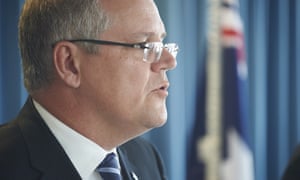Extract from The Guardian
Scott Morrison says government’s budget repair
is ‘patient and measured’ but Labor accuses him of being a
‘one-trick pony’ targeting welfare fraud
Treasurer Scott Morrison has defended the 2020-21
target for returning to surplus, arguing deeper spending cuts or
higher taxes could detract from economic growth. Photograph: Aaron
Bunch/AAP
Daniel
Hurst Political correspondent
Wednesday 16 December 2015 18.18 AEDT
The Turnbull government has dismissed doubts about
the budget savings it says will come from a plan to intensify
existing programs to reduce welfare fraud.
The social services minister, Christian Porter,
described the figures in Scott Morrison’s first budget update as
“absolutely” achievable after Labor suggested the treasurer was a
“one-trick pony” who kept announcing the same crackdown.
Morrison also defended the new 2020-21 target for
returning to surplus, arguing deeper spending cuts or higher taxes
could detract from economic growth. He said introducing them would be
a case of “cutting off your nose to spite your face”, in a clear
break from the Coalition’s previous rhetoric about “Labor’s
debt and deficit disaster”.
Tuesday’s
mid-year economic and fiscal outlook (Myefo) contained deficit
forecasts for the next four years that were $26bn worse than expected
when Joe Hockey handed down his final budget seven months ago. The
deterioration has been largely blamed on revenue write-downs linked
to falling commodity prices and downgrades in economic growth.
The Myefo included several measures described as
“enhanced welfare payment integrity”. It estimated savings of
$1.3bn from increasing the search for discrepancies between income
declared to Centrelink and the Australian Tax Office (ATO) and $695m
from additional matching of social security data with other sources.
A further $158m was expected to come from
expanding the debt recovery activities of the Department of Human
Services.
The new measures were announced seven months after
the government earmarked savings of $1.7bn over five years from
boosting the department’s fraud prevention and debt recovery
capability, and improving assessment processes.
Labor’s treasury spokesman, Chris
Bowen, said the government should justify the figures because
Morrison “pulls this one out of the top drawer” whenever he needs
to find a saving. “He’s a one-trick pony,” Bowen said.
Porter acknowledged the previously announced
welfare crackdowns, but said ministers and departments had been
“impressed with our enhanced ability to use new technology and data
platforms to actually work out where the debt is and then recover the
debt”.
“I guess the central question that you ask is,
are those savings achievable? I absolutely consider that they are ...
and more than that, it’s the right thing to [do],” Porter told
ABC Radio National on Wednesday.
“Previous measures that we put in place are
starting the bear the fruit ... it is not about trusting me as a
minister. These figures are worked through, at arm’s length through
Treasury, through the ATO, based on their recent experience and the
application of new technology they’ve got.”
Morrison conducted a series of media interviews on
Wednesday, a day after delivering the first budget update since
Malcolm Turnbull ousted Tony Abbott as prime minister in September on
the grounds that the country needed better economic leadership.
He stood by cuts within the health portfolio,
including $650m from bulk-billing incentives for pathology and
diagnostic imaging services.
The changes prompted warnings
from the Australian Medical Association that some people could be
deterred from having necessary tests. The Royal College of
Pathologists said it was “dumbfounded” by the decision, which
could prompt people to present late with undiagnosed cancers.
The Labor leader, Bill
Shorten, accused the government of being preoccupied with
“attacking Medicare” rather than intensifying attempts to ensure
multinational corporations paid their fair share of tax.
“An attack on Medicare is an attack on all
Australians,” Shorten said.
But Morrison said pathology was “a very big
business” and the large amount of competition between providers
should maintain downward pressure on prices. He argued that the
government was making the changes because the bulk-billing incentives
had been ineffective.
“Let’s remember that they are paid to the
companies and these are pathology and diagnostic companies, some of
which have turnovers of up to about $4bn a year,” he told Sky News.
“We were shelling out hundreds and hundreds and
hundreds of millions of dollars every year in what were effectively
corporate subsidies to support bulk-billing increases that weren’t
being achieved by those subsidies ... so, why should the tax payer
shell out more for those corporate subsidies?”
Morrison also defended the government’s
slow-and-steady message on budget repair, which clashed with the
messages on deficit reduction deployed by the Abbott-led Coalition
before the 2013 election.
“We are on that path [to surplus] and each year
[the deficit] is reducing by [an] average of 0.4% of GDP, so we make
progress, but you make progress in the economic circumstances and you
don’t cut off your nose to spite your face with higher taxes or
even deeper spending measures,” the treasurer told the ABC’s AM
program.
“You have to be patient and measured and that’s
what the government’s doing to protect people’s jobs.”
Abbott declared “a budget emergency” in 2013
when the former Labor treasurer Wayne Swan’s final budget predicted
deficits of $18bn in 2013-14 and $10.9bn in 2014-15, followed by
narrow predicted surpluses of $800m in 2015-16 and $6.6bn in 2016-17.
The Myefo released by Morrison and the finance
minister, Mathias
Cormann, suggested the budget will remain in the red by $37.4bn
in 2015-16, followed by deficits of $33.7bn in 2016-17, $23bn in
2017-18 and $14.2bn in 2018-19.

No comments:
Post a Comment